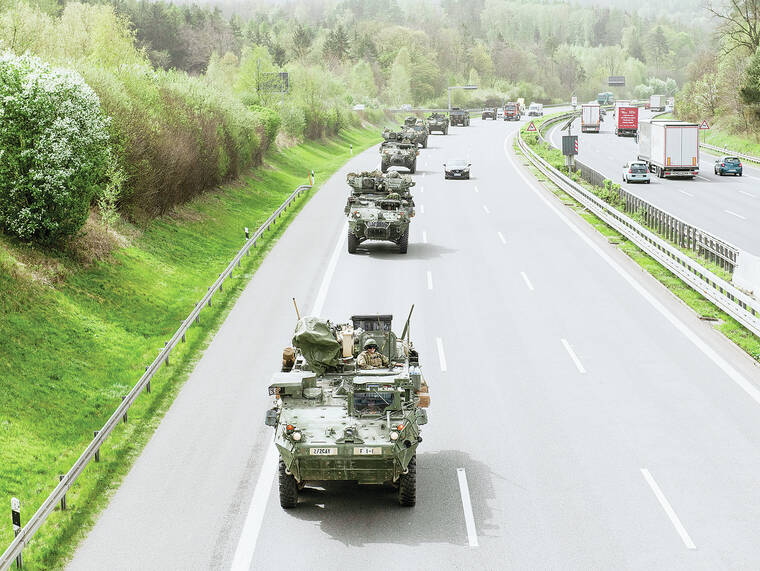NATO puts on a show of force in the shadow of Russia’s war
JEDRZYCHOWICE, Poland — About 90,000 NATO troops have been training in Europe this spring for the Great Power war that most hope will never come: a clash between Russia and the West with potentially catastrophic consequences.
In Estonia, paratroopers from the 82nd Airborne Division out of Fort Liberty, North Carolina, jumped out of planes alongside soldiers from Colchester Garrison in Essex, Britain, for “forcible entry” operations. In Lithuania, German soldiers arrived as a brigade stationed outside Germany on a permanent basis for the first time since World War II.
ADVERTISING
And on the A4 autobahn in eastern Germany, a U.S. Army captain and his Macedonian counterpart rushed toward the Suwalki Gap — the place many war planners predict will be the flashpoint for a NATO war with Russia — hoping the overheated radiator on their Stryker armored combat vehicle wouldn’t kill the engine.
All are part of what is supposed to be a tremendous show of force by NATO, its largest since the start of the Cold War, that is meant to send a sharp message to President Vladimir Putin of Russia that his ambitions must not venture beyond Ukraine.
But it is also a preview of what the opening beats of a modern Great Power conflict could look like. If NATO and Russia went to war, U.S. and allied troops would initially rush to the Baltic countries Estonia, Latvia and Lithuania — NATO’s “Eastern Flank”— to try to block penetration by a Russian force.
How that war would end, and how many people might die, is a different story. Tens of millions of people were killed in World War II. This time, the stakes have never been higher. Putin has brought up the potential for nuclear war several times since Russia invaded Ukraine more than two years ago.
National security officials are making plans for cyberwarfare, too, including how to defend U.S. and NATO interests against a possible cyberattack on public infrastructure.
But a European continental ground war has seemed far more possible since Russia invaded Ukraine.
“This exercise changes the calculus for our adversaries — that’s the real power of this,” said Gen. Darryl A. Williams, the American general who leads NATO’s Allied Land Command. Putin, he said, “is watching this and saying, ‘Hmm, maybe I need to think twice here.’”
Western military officials believe the Suwalki Gap is likely to be the first territory that Moscow would try to take. Russian forces in Kaliningrad, assisted by Russia’s ally Belarus, could move in, isolating the Baltic countries if successful.
The road march is supposed to test how quickly NATO can get troops to the Suwalki Gap.
The road march culminated with a live-fire exercise in a training area near Suwalki, with 1,800 2nd Cavalry troops joining 2,600 troops from nine other countries to establish what the military called an “enhanced forward presence” to protect NATO’s eastern flank. The troops blew up pop-up targets and seized territory. American Apache helicopters made passes and gave covering fire, while, from an even higher altitude, Polish F-16 and Italian F-35 fighter jets conducted airstrikes.
NATO’s ability to “bring together these seemingly disparate units from different nations to conduct something so complex is what sets us apart,” said Col. Martin O’Donnell, a spokesperson for the U.S. Army Europe and Africa. It was, he said, a demonstration of “combined arms” maneuvering.
Neither Russia nor Ukraine has been able to do combined arms, where all parts of a maneuver force — air, land and, sometimes, sea — coordinate and work in concert. Tanks and artillery, and even airstrikes, hit a target before infantry soldiers go in.
Williams, the NATO land forces commander, said that in the past, such exercises did not name the enemy — there was just a fictitious opponent.
Not so this year. For the first time, “we now, in this year, are actually fighting an exercise against the Russians,” he said. “We fight against our potential adversary.”
© 2024 The New York Times Company





